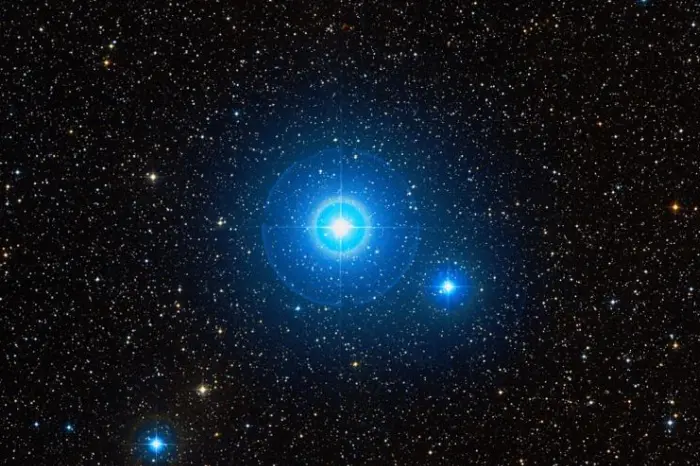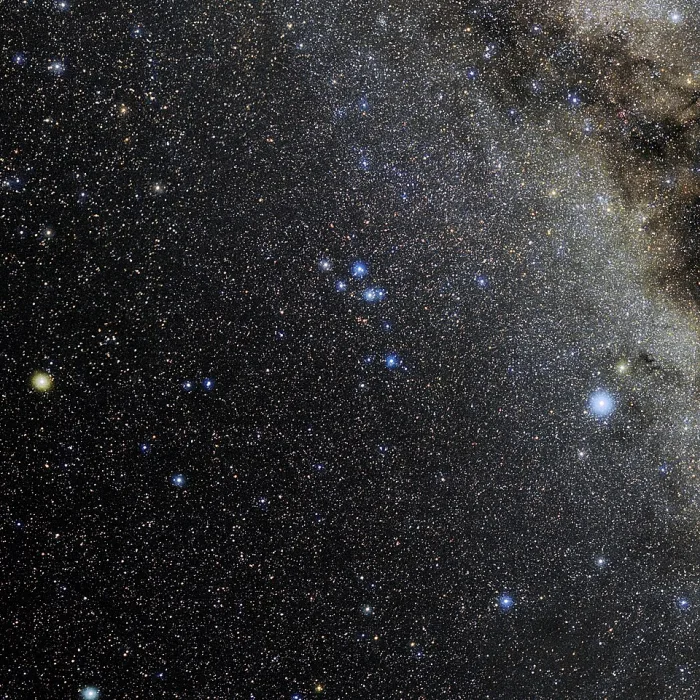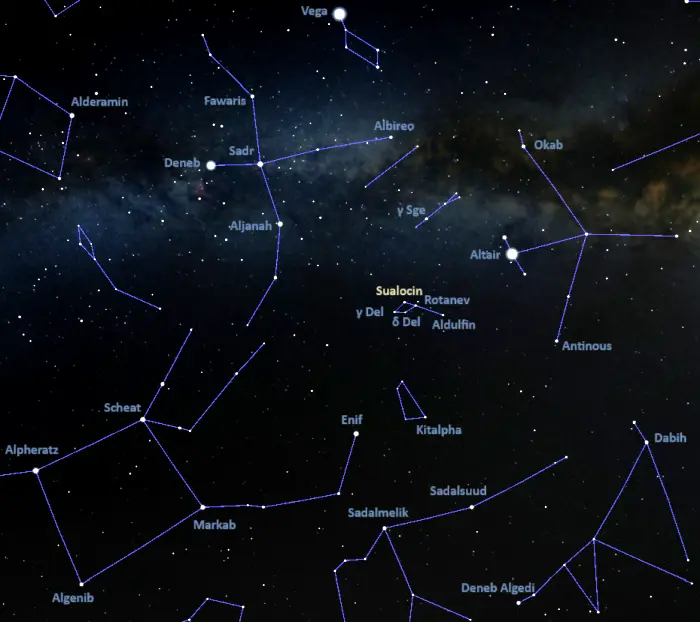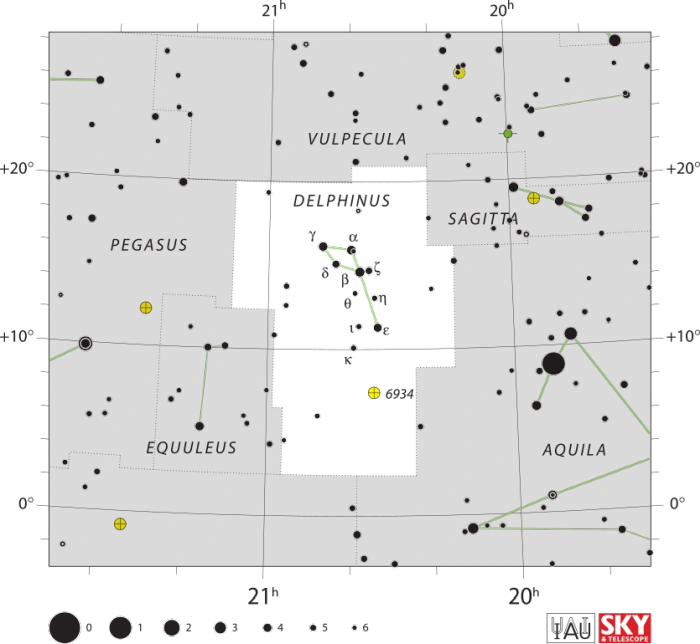Sualocin, Alpha Delphini (α Del), is a multiple star system located approximately 254 light years away in the northern constellation of Delphinus. With a combined apparent magnitude of 3.777, it is the second brightest point of light in the constellation, after Rotanev (Beta Delphini). It forms the distinctive constellation figure of the Dolphin with Rotanev, Aldulfin, and the fainter Gamma and Delta Delphini.
Star system
Alpha Delphini is a triple star system composed of a spectroscopic binary star one of whose components is itself a binary system. The three components are designated Alpha Delphini A, Alpha Delphini Ba and Alpha Delphini Bb, or alternatively Alpha Delphini Aa, Ab1 and Ab2.
The primary component, Alpha Delphini A (or Aa), is an evolved hot blue subgiant star of the spectral type B9 IV. It has 3.83 times the Sun’s mass, a radius of 3.92 solar radii, and a surface temperature of 11,643 K. The star is a fast spinner, with a projected rotational velocity of 144 km/s. It has an estimated age of 227 million years.
Alpha Delphini A and Alpha Delphini B orbit each other with a period of 6,175.3 ± 3.2 days and are separated by only 0.15809 arcseconds in the sky, corresponding to a physical distance of 12.7 astronomical units (AU).
Alpha Delphini Ba and Alpha Delphini Bb have an orbital period of 29.9873 ± 0.0021days. They are separated by 0.0003587 arcseconds, corresponding to an orbital distance of 0.281 astronomical units. This is only 28.1% of the average distance from the Earth to the Sun.
The more massive of the two components is believed to be an A-type main sequence star, while the fainter star is likely an F-type star. The components have masses of 1.82 and 1.49 solar masses.
The Alpha Delphini system has five optical companions sometimes referred to as Alpha Delphini B, C, D, E and F. These stars shine at 11th to 13th magnitude and appear 35 to 72 arcseconds from Alpha Delphini. They are not physically bound to the Sualocin system. They have smaller parallaxes and do not share a common proper motion with Alpha Delphini.

Sualocin (Alpha Delphini), image credit: ESO/Digitized Sky Survey 2 (CC BY 4.0)
Facts
Sualocin was discovered to be a binary star by Wickes in 1975. He resolved a close binary companion at a separation of about 200 milliarcseconds using the Mt. Wilson 60-inch telescope. The companion was found to be 2 magnitudes fainter than Sualocin.
In 2020, observations with the Michigan InfraRed Combiner-Exeter (MIRC-X) at the CHARA Array led to the discovery of the third component in the system. The component Alpha Delphini B was found to be a binary system with an orbital period of 30 days. A team of astronomers led by Tyler Gardner, Astronomy Department, University of Michigan, found masses of 3.83 ± 0.33, 1.82 ± 0.15 and 1.49 ± 0.12 for Alpha Delphini A, Alpha Delphini Ba and Alpha Delphini Bb.
Sualocin forms an asterism known as Job’s Coffin with Rotanev (Beta Delphini), Gamma Delphini, and Delta Delphini. The star pattern outlines the body of the celestial Dolphin. Aldulfin (Epsilon Delphini) marks the Dolphin’s tail and completes the constellation figure of Delphinus.

Photo of the constellation Delphinus produced by NOIRLab in collaboration with Eckhard Slawik, a German astrophotographer. Image credit: E. Slawik/NOIRLab/NSF/AURA/M. Zamani (CC BY 4.0)
Name
The name Sualocin (pronunciation: /ˈswɒloʊsɪn/) comes from the name Nicolaus written in reverse. Nicolaus Venator (Nicholas Hunter) was the Latinized name of the Italian astronomer Niccolò Cacciatore, assistant to Giuseppe Piazzi, whom he later succeeded as director of the Palermo Observatory. The name of Beta Delphini, Rotanev, is Venator in reverse. Both names first appeared in Piazzi’s Palermo Star Catalogue of 1814. The stars were listed as Rotanen and Scalovin in American astronomer Elijah Hinsdale Burritt’s Atlas of 1856.
The origin of the names was unknown for several decades until the Reverend Thomas Webb, a British astronomer, worked out the puzzle. He revealed the explanation in his Celestial Objects for Common Telescopes of 1859.
The International Astronomical Union’s (IAU) Working Group on Star Names (WGSN) approved the name Sualocin for Alpha Delphini on September 12, 2016. The name formally applies only to the primary component, Alpha Delphini Aa, but it is commonly used for the whole star system.
In old Chinese astronomy, Alpha Delphini was known as 瓠瓜一 (Hù Guā yī), the First Star of Good Gourd. It formed the Good Gourd asterism with Rotanev (Beta Delphini), Gamma2 Delphini, and Delta Delphini. The star pattern was part of the Girl mansion, one of the northern mansions of the Black Tortoise.
Location
Sualocin is easy to find from areas without too much light pollution. The star is part of the recognizable constellation figure of the Dolphin, which appears about a third of the way from the bright Altair (Alpha Aquilae) in the constellation Aquila (the Eagle) to the Great Square of Pegasus in Pegasus and Andromeda. Sualocin is the nearest of the five relatively bright Delphinus stars to Sagitta (the Arrow).
Alpha Delphini can be used to find the bright planetary nebula NGC 6891. The nebula lies roughly halfway between the star and Altair.
At declination +16°, Sualocin is visible from virtually any location on Earth for at least part of the year.

Sualocin location, image: Stellarium
Constellation
Sualocin is located in the constellation Delphinus. The Dolphin is one of the most distinctive northern constellations. It is easily recognizable because its five brightest stars outline the shape of a dolphin in the sky.
Delphinus was one of the 48 ancient constellations catalogued by the Greco-Roman astronomer Claudius Ptolemy of Alexandria in his Almagest in the 2nd century AD. It is one of the smaller northern constellations, stretching across only 189 square degrees.
In Greek mythology, the constellation is associated with Poseidon’s messenger, who found the Nereid Amphitrite and convinced her to marry the sea god. Delphinus is also associated with the dolphin that rescued he Greek poet and musician Arion at sea and carried him to the coast of Greece to safety.
The brightest stars in Delphinus shine at fourth magnitude. The constellation’s lucida, the yellow-white giant Rotanev (Beta Delphini), has a visual magnitude of 3.617 and lies around 101 light-years away.
Other notable stars in Delphinus include the hot blue giant Aldulfin (Epsilon Delphini), the binary star systems Gamma and Kappa Delphini, the Delta Scuti variable Delta Delphini, the yellow giant Musica (18 Delphini), the orange supergiant Theta Delphini, the K-type giant 17 Delphini, the white subgiants Eta and Iota Delphini, and the white main sequence stars Zeta Delphini and Rho Aquilae. Rho Aquilae belonged to the constellation Aquila until 1992, when it migrated into Delphinus. It still has its old Bayer designation.

Delphinus constellation map by IAU and Sky&Telescope magazine (Roger Sinnott & Rick Fienberg) (CC BY 3.0)
Delphinus also hosts the classical nova system V339 Delphini (Nova Delphini 2013) and the yellow symbiotic star system He 2-467.
Notable deep sky objects in the constellation include the bright globular clusters NGC 6934 (C47) and NGC 7006 (C42), the planetary nebulae NGC 6891 and the Blue Flash Nebula (NGC 6905), and the spiral galaxies NGC 7003, NGC 7025, and NGC 6956.
The best time of the year to see the stars and deep sky objects in Delphinus is during the month of September, when the constellation is high above the horizon in the early evening. The entire constellation can be seen from locations north of the latitude 69° S.
The 10 brightest stars in Delphinus are Rotanev (Beta Del, mag. 3.617), Sualocin (Alpha Delphini, mag. 3.777), Aldulfin (Epsilon Delphini, mag. 4.03), Gamma Delphini (mag. 4.360), Delta Delphini (mag. 4.43), Zeta Delphini (mag. 4.647), Rho Aquilae (mag. 4.94), Kappa Delphini (mag. 5.05), 17 Delphini (mag. 5.18), and Eta Delphini (mag. 5.38).
Sualocin – Alpha Delphini
| Spectral class | B9 IV |
| U-B colour index | -0.205 |
| B-V colour index | -0.061 |
| Apparent magnitude | 3.777 (3.86 + 6.43) |
| Absolute magnitude | −0.4 |
| Distance | 254 ± 9 light-years (78 ± 3 parsecs) |
| Parallax | 13.7298 ± 0.3502 mas |
| Radial velocity | −3.40 ± 3.7 km/s |
| Proper motion | RA: 71.574 ± 0.340 mas/yr |
| Dec.: -30.655 ± 0.270 mas/yr | |
| Mass (α Del A) | 3.83 ± 0.33 M☉ |
| Mass (α Del Ba) | 1.82 ± 0.15 M☉ |
| Mass (α Del Bb) | 1.49 ± 0.12 M☉ |
| Radius (α Del A) | 3.92 R☉ |
| Temperature (α Del A) | 11,643 K |
| Age (α Del A) | 227 million years |
| Rotational velocity (α Del A) | 144 km/s |
| Surface gravity (α Del A) | 3.93 cgs |
| Constellation | Delphinus |
| Right ascension | 20h 39m 38.2796355689s |
| Declination | +15° 54′ 43.776032197″ |
| Names and designations | Sualocin, Alpha Delphini, Alpha Del, α Delphini, α Del, HD 196867, HR 7906, HIP 101958, SAO 106357, BD+15 4222, AG+15 2267, FK5 774, GC 28780, GCRV 12943, PLX 4923.00, PPM 138790, WCK 2, BU 298A, HJ 1554A, GEN# +1.00196867, SKY# 39141, GSC 01633-02442, HGAM 941, PMC 90-93 545, AKARI-IRC-V1 J2039383+155443, ALS 15096, CSI+15 4222 1, WEB 18427, JP11 3262, N30 4569, SRS 30774, ROT 3015, TD1 27089, TIC 340798509, WISE J203938.34+155443.5, WISEA J203938.36+155443.6, UBV 17924, UBV M 25064, YZ 15 8312, IRAS 20373+1544, IRAS F20373+1544, 2MASS J20393829+1554433, TYC 1633-2442-1, Gaia DR2 1810711143450256128, Gaia DR3 1810711143451975296, ADS 14121 AG, CCDM J20396+1555, CCDM J20396+1555AG, IDS 20350+1534 AG, WDS J20396+1555, WDS J20396+1555Aa,Ab |